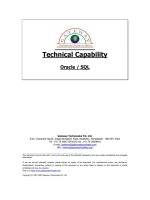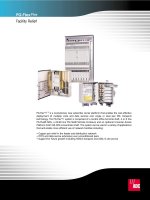Tài liệu ADM389 IPv6 docx
Bạn đang xem bản rút gọn của tài liệu. Xem và tải ngay bản đầy đủ của tài liệu tại đây (415.63 KB, 52 trang )
ADM389
IPv6
Rafal Lukawiecki
www.projectbotticelli.co.uk
Strategic Consultant
Project Botticelli Ltd
in association with
www.ip426.com
2
Objectives
Make a (brief) case for IPv6 (level 200)
Give you a crash-course on the main
aspects of the protocol (level 300)
Explain the available technology support
including migration strategies (level 300)
3
Why IPv6?
4
IP Address Allocation History
1981 - IPv4 protocol published
1985 ~ 1/16 of total space
1990 ~ 1/8 of total space
1995 ~ 1/3 of total space
2000 ~ 1/2 of total space
2002.5 ~ 2/3 of total space
This despite increasingly intense conservation efforts:
PPP / DHCP address sharing
NAT (network address translation)
CIDR (classless inter-domain routing)
plus some address reclamation
Theoretical limit of 32-bit space: ~4 billion devices
Practical limit of 32-bit space: ~250 million devices (RFC 3194)
5
Running Out of Addresses
Even if every company used only 1
address by fully utilising NATs (Network
Address Translation)…
…we would be out of addresses in the
next 3-5 years
“Slower that Y2K problem, but a surer
one”
6
More IPv4 Pain
Argh, NATs
Peer-to-peer is difficult
NAT security record is dubious
Management is a pain
Security is an optional add-on
QoS (Quality of Service) is rare and not real-time
Routing tables too large and process slow
Mobility is a pain
But peer-to-peer mobility is the future of Internet
Device autoconfiguration is rare
DHCP & address ownership does not work across
organisational boundaries
Using external agents for autoconfiguration is a non-starter
7
US versus ROW
US accounts for 90% of address allocation
Some universities in US have more allocated
addresses than the whole of Asia
The so-called, in US, “Rest of the World” is
hardly an even partner
Reliance on American organisations may be
politically difficult, at times, for large or
governmental Internet projects
Gives US an unwelcome monopoly power
8
6 Benefits of IPv6
Address depletion solved
International misallocation solved
End-to-end communication restored
Scoped addresses & address selection
More efficient forwarding
Built-in security and mobility
9
Who’s Doing IPv6?
More places than you would think!
Japanese city of Kyoto (now)
JANET (Joint Academic Network) in UK
US Deparment of Defence
June 13
th
2003 decision made by Pentagon (
/>=738&e=6&u=/afp/20030613/tc_afp/us_military_internet
)
Planning and preparation in 2003-4
Transition in 2005
Completion in 2008
10
Crash Course on IPv6
11
Features of IPv6
New header format
Large address space
Efficient and hierarchical addressing and
routing infrastructure
Stateless and stateful address configuration
Built-in security
Better support for QoS
New protocol for neighboring node interaction
Extensibility
12
Differences Between IPv4 & IPv6
Feature IPv4 IPv6
Address length 32 bits 128 bits
IPSec support Optional Required
QoS support Some Better
Fragmentation Hosts and routers Hosts only
Packet size 576 bytes 1280 bytes
Checksum in header Yes No
Options in header Yes No
Link-layer address resolution ARP (broadcast) Multicast Neighbor
Discovery Messages
Multicast membership IGMP Multicast Listener
Discovery (MLD)
Router Discovery Optional Required
Uses broadcasts Yes No
Configuration Manual, DHCP Automatic, DHCP
DNS name queries Uses A records Uses AAAA
records
DNS reverse queries Uses IN-ADDR.ARPA Uses IP6.INT
13
IPv6 Terminology
Additional subnets
Router
Host
Neighbors
Host Host
Intra-subnet
router
Bridge
LAN segment
Link
Subnet
Network
14
The IPv6 Address Space
128-bit address space
2128 possible addresses
340,282,366,920,938,463,463,374,607,431,768,211,456
addresses (3.4 x 10
38
)
6.65 x 10
23
addresses per square metre of Earth’s
surface
128 bits were chosen to allow multiple levels of
hierarchy and flexibility in designing
hierarchical addressing and routing
Typical unicast IPv6 address:
64 bits for subnet ID, 64 bits for interface ID
15
IPv6 Address Syntax
IPv6 address in binary form:
0010000111011010000000001101001100000000000000000010111100111011
0000001010101010000000001111111111111110001010001001110001011010
Divided along 16-bit boundaries:
0010000111011010 0000000011010011 0000000000000000 0010111100111011
0000001010101010 0000000011111111 1111111000101000 1001110001011010
Each 16-bit block is converted to
hexadecimal and delimited with colons:
21DA:00D3:0000:2F3B:02AA:00FF:FE28:9C5A
Suppress leading zeros within each 16-bit
block:
21DA:D3:0:2F3B:2AA:FF:FE28:9C5A
16
Compressing Zeros
Some IPv6 addresses contain long sequences
of zeros
A single contiguous sequence of 16-bit blocks
set to 0 can be compressed to “::” (double-
colon)
Example:
FE80:0:0:0:2AA:FF:FE9A:4CA2 becomes
FE80::2AA:FF:FE9A:4CA2
FF02:0:0:0:0:0:0:2 becomes FF02::2
Cannot use zero compression to include part of
a 16-bit block
FF02:30:0:0:0:0:0:5 does not become FF02:3::5.
17
IPv6 Prefixes
Prefix is the part of the address where the
bits have fixed values or are the bits of a
route or subnet identifier
IPv6 subnets or routes always uses
address/prefix-length notation
CIDR notation
Examples:
21DA:D3::/48 for a route
21DA:D3:0:2F3B::/64 for a subnet
No more dotted decimal subnet masks!
18
Types of IPv6 Addresses
Unicast
Address of a single interface
One-to-one delivery to single interface
Multicast
Address of a set of interfaces
One-to-many delivery to all interfaces in the set
Anycast
Address of a set of interfaces
One-to-one-of-many delivery to a single interface in
the set that is closest
No more broadcast addresses
19
Unicast IPv6 Addresses
Aggregatable global unicast addresses
Link-local addresses
Site-local addresses
Special addresses
Compatibility addresses
NSAP addresses
20
Aggregatable Global Unicast
Addresses
Top-Level Aggregation ID (TLA ID)
Next-Level Aggregation ID (NLA ID)
Site-Level Aggregation ID (SLA ID)
Interface ID
TLA ID Interface ID
13 bits 64 bits
SLA ID
24 bits
001 NLA ID
16 bits
Res
8 bits
21
Topologies Within Global
Addresses
Public Topology
Site Topology
Interface ID
TLA ID Interface ID
64 bits
SLA ID001 NLA ID
16 bits
Res
48 bits
Public Topology
Site Topology Interface Identifier
22
Local-Use Unicast Addresses
Link-local addresses
Used between on-link neighbors and for
Neighbour Discovery
Site-local addresses
Used between nodes in the same site
23
Link-Local Addresses
Format Prefix 1111 1110 10
FE80::/64 prefix
Used for local link only
Single subnet, no router
Address autoconfiguration
Neighbor Discovery
1111 1110 10 Interface ID
10 bits 64 bits
000 . . . 000
54 bits
24
Site-Local Addresses
Format Prefix 1111 1110 11
FEC0::/48 prefix for site
Used for local site only
Replacement for IPv4 private addresses
Intranets not connected to the Internet
Routers do not forward site-local traffic
outside the site
1111 1110 11 Interface ID
10 bits 64 bits
000 . . . 000
38 bits
Subnet ID
16 bits
25
NSAP Addresses
0000001 NSAP-mapped address
7 bits 121 bits









